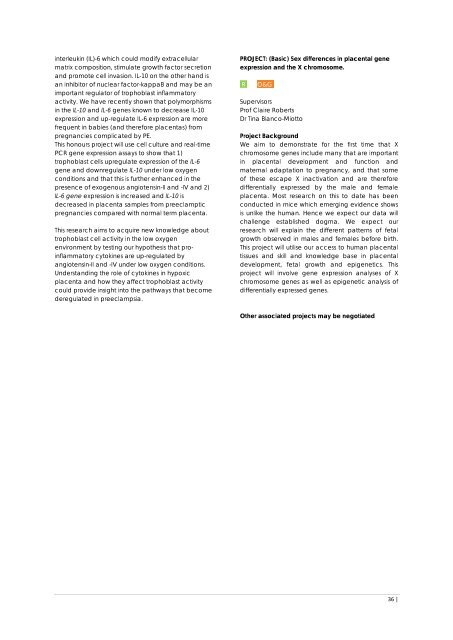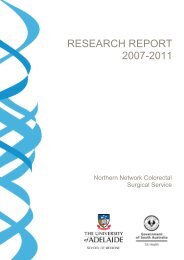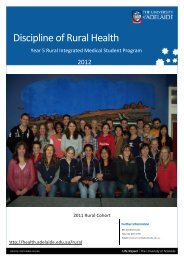Honours Project Book - Faculty of Health Sciences - University of ...
Honours Project Book - Faculty of Health Sciences - University of ...
Honours Project Book - Faculty of Health Sciences - University of ...
Create successful ePaper yourself
Turn your PDF publications into a flip-book with our unique Google optimized e-Paper software.
interleukin (IL)-6 which could modify extracellular<br />
matrix composition, stimulate growth factor secretion<br />
and promote cell invasion. IL-10 on the other hand is<br />
an inhibitor <strong>of</strong> nuclear factor-kappaB and may be an<br />
important regulator <strong>of</strong> trophoblast inflammatory<br />
activity. We have recently shown that polymorphisms<br />
in the IL-10 and IL-6 genes known to decrease IL-10<br />
expression and up-regulate IL-6 expression are more<br />
frequent in babies (and therefore placentas) from<br />
pregnancies complicated by PE.<br />
This honours project will use cell culture and real-time<br />
PCR gene expression assays to show that 1)<br />
trophoblast cells upregulate expression <strong>of</strong> the IL-6<br />
gene and downregulate IL-10 under low oxygen<br />
conditions and that this is further enhanced in the<br />
presence <strong>of</strong> exogenous angiotensin-II and -IV and 2)<br />
IL-6 gene expression is increased and IL-10 is<br />
decreased in placenta samples from preeclamptic<br />
pregnancies compared with normal term placenta.<br />
This research aims to acquire new knowledge about<br />
trophoblast cell activity in the low oxygen<br />
environment by testing our hypothesis that proinflammatory<br />
cytokines are up-regulated by<br />
angiotensin-II and -IV under low oxygen conditions.<br />
Understanding the role <strong>of</strong> cytokines in hypoxic<br />
placenta and how they affect trophoblast activity<br />
could provide insight into the pathways that become<br />
deregulated in preeclampsia.<br />
PROJECT: (Basic) Sex differences in placental gene<br />
expression and the X chromosome.<br />
R. O&G.<br />
Supervisors<br />
Pr<strong>of</strong> Claire Roberts<br />
Dr Tina Bianco-Miotto<br />
<strong>Project</strong> Background<br />
We aim to demonstrate for the first time that X<br />
chromosome genes include many that are important<br />
in placental development and function and<br />
maternal adaptation to pregnancy, and that some<br />
<strong>of</strong> these escape X inactivation and are therefore<br />
differentially expressed by the male and female<br />
placenta. Most research on this to date has been<br />
conducted in mice which emerging evidence shows<br />
is unlike the human. Hence we expect our data will<br />
challenge established dogma. We expect our<br />
research will explain the different patterns <strong>of</strong> fetal<br />
growth observed in males and females before birth.<br />
This project will utilise our access to human placental<br />
tissues and skill and knowledge base in placental<br />
development, fetal growth and epigenetics. This<br />
project will involve gene expression analyses <strong>of</strong> X<br />
chromosome genes as well as epigenetic analysis <strong>of</strong><br />
differentially expressed genes.<br />
Other associated projects may be negotiated<br />
36 |





